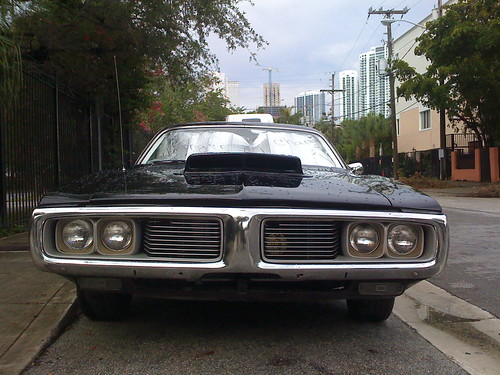Friday, March 5: Bandersnatches
WHAT’S DRIVING MISS DAISY?
by Steven Steinbock

There are days – most days in fact – when I have a hard time getting motivated with my writing. I may be running low on fuel, or in need of a tune up. Some of my pistons may not be firing. Sometimes I forget to set my GPS and just lose my way.
I just came back from Staples, and stopped for gas on the way home, so I’ve got automotive analogies on the brain. As a writer, I’m a lot like a car. I do need things like fuel and tune-ups, and occasionally I even need to be washed. Today, as I checked my mental timing-belt, I noticed that my characters were slipping.
Bear with me. I’m about to propose a metaphor within a metaphor. Or maybe it’s an analogy within an analogy. A metaphor within an analogy?
Within my own writer’s engine, there’s a character who seems to have lost his way. I say seems because if you ask him, everything is fine. But as his creator, I look down on him with a hyper-critical eye and ask him what drives him.
“Paul,” I say to him. “What’s your motivation?”
He looks up from his work and says, “Excuse me?”
“Your motivation, Paul. Why do you do what you do? You are happily going along, helping others, bending the law at your leisure. I want to know why.”
Paul is silent. He gets like that sometimes.
But another character – a guy named Mikey – pipes in, “Why? We’re just characters in a story. What do we need motives for?”
“Everyone needs a motive,” I tell him. “Without motives, you guys are like cardboard cutouts.” In the background, Paul remains contemplative.
“But we’re just short story characters,” Mikey says, taking a big gulp of Mountain Dew. “I’d see your point if you wrote a whole book about us. I get it. But as it is, we’ve got to get in there, do what we do to tell your story, and get out. We don’t have time for no stinking motives.”
“That’s no excuse. Even if you or I don’t explicitly tell the reader your motive – which is probably not a good idea anyhow – you still have to have something that drives you.”
“What drives Michael Weston?” he asks.
“Michael who?”
“Michael Weston. Dude, he’s the guy on Burn Notice. Where have you been? On the USA Network where characters are welcome. He doesn’t do what he does for money. And if you think it’s because his mother says ‘someone needs your help, Michael,’ well, what kind of action hero listens to his mother anyhow?”
“Isn’t that Sharon Gless from Cagney and Lacey?” I ask.
“Cagney and who?”
“Michael Weston has plenty of motives. He wants to be close to Fiona. He wants to keep his mother safe. He wants to make Miami better place with fewer mobsters. And moreover, he wants to know who put a burn notice on him and he wants to get it overturned. It’s TV. The motives may be thin and clichéd, but they’re there.”
“If I could be close to Fiona,” Mikey says, “I’d be perfectly happy with thin and clichéd motives.”
I laugh.
Then Paul reenters the conversation. “What happened to your automotive metaphor?”
I’m not sure, I think to myself as the two characters disappear back into the story from which they emerged.
I get up from my keyboard and pour myself another cup of coffee, thick as oil. “I’m not sure,” I say to anyone who might be listening. “But I’ll let you know when I get there.”
TRUE CONFESSIONS
 In various columns in the past (see here, here , and here) I’ve discussed the importance of G.K. Chesterton, and in particular the importance of his first “Father Brown” story, “The Blue Cross.” I’ve fine-tuned those ideas, and I’m happy to announce – in a moment of blatant self-promotion – that Mystery Scene Magazine has just published my article on the subject.
In various columns in the past (see here, here , and here) I’ve discussed the importance of G.K. Chesterton, and in particular the importance of his first “Father Brown” story, “The Blue Cross.” I’ve fine-tuned those ideas, and I’m happy to announce – in a moment of blatant self-promotion – that Mystery Scene Magazine has just published my article on the subject.
I’ve seen an advance copy, and I can say that I’m very pleased with it. Kate and Brian put my article in the very middle of the magazine, taking advantage of their section of color pages to make the most of the illustrations that they used to decorate my story.
Subscribers should be getting their copies by mail soon. Non-subscribers should subscribe, and short of that, should climb into their automobiles – metaphorical or real – and drive to their favorite bookstore and ask for a copy.





















Sincere congratulations (!) on the Mystery Scene article. I look forward to reading it.
Thanks, John.
And thanks to our esteemed boss JLW for the 1973 Charger illustration at the top of my column. That’s Michael Westen’s car from “Burn Notice.”
Hmm, if I’d used “Supernatural” as an example there’s be a ’67 Impala up there.
It’s a show biz cliché for an actor to ask his director, “What’s my motivation?”
Character motivation is an essential part of story-telling, but one of the characteristics of a good short story is that only those character elements essential to the plot need to be exposited. Thus character motivation need only be explored in direct regard to the events depicted; all else is irrelevant. This is why “backstory” is so deadly to a good tale.
I’m a big fan of Burn Notice, and I love Michael’s car. My first car was a 1972 V-8 Ford Torino, and let me tell you, that car was a rocket.
I very much enjoyed this post, Steve.
Thank you.
Congratulations again, Steve!
Just read your article in Mystery Scene and enjoyed it a lot. Didn’t know this was J. Brown’s centennial year. I think my favorite story is “The Scandal of Father Brown,” in which the paradox is the romanticism of the allegedly cynical reporter.
My favorite line from GKC: “I am a journalist, and have no earthly motives except curiosity and personal vanity.”